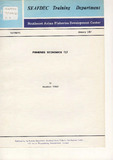| dc.contributor.author | Sornkliang, Jariya | |
| dc.contributor.author | Sina, Norm | |
| dc.contributor.author | Leakhna, Chin | |
| dc.contributor.author | Sophea, Lao | |
| dc.contributor.author | Khine Mar, Myat | |
| dc.contributor.author | Yenpoeng, Thana | |
| dc.contributor.author | Kaewtankam, Varantorn | |
| dc.contributor.author | Pholcharoen, Jasmine | |
| dc.contributor.author | Suasi, Thanyalak | |
| dc.contributor.author | Tiaye, Rattana | |
| dc.contributor.author | Sarapaivanich, Kongpathai | |
| dc.contributor.author | Suthipol, Yanida | |
| dc.date.accessioned | 2020-05-26T03:20:02Z | |
| dc.date.available | 2020-05-26T03:20:02Z | |
| dc.date.issued | 2018 | |
| dc.identifier.citation | Sornkliang, J., Sina, N., Leakhna, C., Sophea, L., Khine Mar, M., Yenpoeng, T., . . . Suthipol, Y. (2107). Understanding of Gender Situation in Small-scale Fisheries of Southeast Asia Through Fisheries Value Chain: Case Study in Cambodia, Myanmar and Thailand . SEAFDEC Technical Seminar 2018 (pp. 10-15). Samut Prakan: Training Department, Southeast Asian Fisheries Development Center | en |
| dc.identifier.uri | http://hdl.handle.net/20.500.12067/1439 | |
| dc.description.abstract | Gender aspect was promoted to integrate in to development program for archiving suitable development. Therefore, Gender role in fisheries sector is important to understand. At the present, men and women have been playing an important role in the fisheries sector, which both of them have different responses depending on the situations or tasks. Therefore, the gender study in fishing community would be shown the significant difference of role, participation, accession, control, and limitation in the decision making to develop the coastal area in their community. The study sites are the coastal fishing community in Cambodia, Myanmar, and Thailand. The results of the study found that there was equitability for men and women to access and control the use of fishery resources and right to fishing. Especially, men have been playing the role as majority in the fisheries sector on catching and processing of fish onboard; while women have taken a role in fish selling and processing. However, there was no significant difference between men and women because the responsibilities were identified by themselves accordingly with their gender | en |
| dc.language.iso | en | en |
| dc.publisher | Training Department, Southeast Asian Fisheries Development Center | en |
| dc.subject | gender | en |
| dc.subject | roles | en |
| dc.subject | fisheries | en |
| dc.subject | Value chain | en |
| dc.subject | livelihood | en |
| dc.title | Understanding of Gender Situation in Small-scale Fisheries of Southeast Asia Through Fisheries Value Chain: Case Study in Cambodia, Myanmar and Thailand | en |
| dc.type | Conference paper | en |
| dc.citation.spage | 10 | en |
| dc.citation.epage | 15 | en |
| dc.citation.conferenceTitle | SEAFDEC Technical Seminar 2018 | en |




